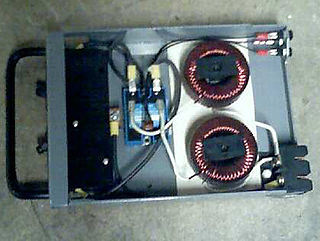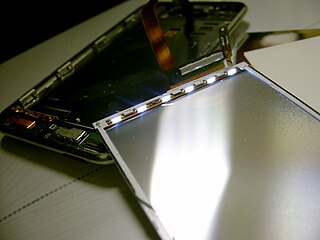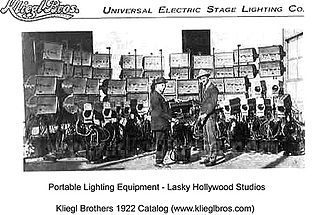
Stage lighting is the craft of lighting as it applies to the production of theater, dance, opera, and other performance arts. Several different types of stage lighting instruments are used in this discipline. In addition to basic lighting, modern stage lighting can also include special effects, such as lasers and fog machines. People who work on stage lighting are commonly referred to as lighting technicians or lighting designers.

DMX512 is a standard for digital communication networks that are commonly used to control stage lighting and effects. It was originally intended as a standardized method for controlling light dimmers, which, prior to DMX512, had employed various incompatible proprietary protocols. It soon became the primary method for linking controllers to dimmers and special effects devices such as fog machines and intelligent lights. DMX has also expanded to uses in non-theatrical interior and architectural lighting, at scales ranging from strings of Christmas lights to electronic billboards and stadium or arena concerts. DMX can now be used to control almost anything, reflecting its popularity in theaters and venues.

Dimmers are devices connected to a light fixture and used to lower the brightness of light. By changing the voltage waveform applied to the lamp, it is possible to lower the intensity of the light output. Although variable-voltage devices are used for various purposes, the term dimmer is generally reserved for those intended to control light output from resistive incandescent, halogen, and compact fluorescent lights (CFLs) and light-emitting diodes (LEDs). More specialized equipment is needed to dim fluorescent, mercury vapor, solid-state, and other arc lighting.

A lighting control console is an electronic device used in theatrical lighting design to control multiple lights at once. They are used throughout the entertainment industry and are normally placed at the front of house (FOH) position or in a control booth.
Neve Electronics was a manufacturer of music recording and broadcast mixing consoles and hardware. It was founded in 1961 by Rupert Neve, the man credited with creating the modern mixing console.
In theatre, the master electrician is responsible for implementing the lighting design for a production drawn up by the lighting designer. This involves overseeing the preparation, hanging, connection and focusing of stage lighting fixtures.

Show control is the use of automation technology to link together and operate multiple entertainment control systems in a coordinated manner. It is distinguished from an entertainment control system, which is specific to a single theatrical department, system or effect, one which coordinates elements within a single entertainment discipline such as lighting, sound, video, rigging or pyrotechnics. A typical entertainment control system would be lighting control. An example of show control would be linking a video segment with a number of lighting cues, or having a sound track trigger animatronic movements -- or all of these combined. Shows with or without live actors can almost invariably incorporate entertainment control technology and usually benefit from show control to operate these subsystems independently, simultaneously, or in rapid succession.
D54 is an analogue lighting communications protocol used to control stage lighting. It was developed by Strand Lighting in the late 1970s and was originally designed to handle 384 channels. Though more advanced protocols exist such as Digital MultipleX DMX (lighting), it was widely used in larger venues such as London's West End theatres which had Strand Lighting dimming installations, and it was popular amongst technicians because all the levels can be "seen" on an oscilloscope. D54 is still supported on legacy equipment such as the Strand 500 series consoles alongside DMX. Generally a protocol converter is now used to convert DMX (lighting) down to the native D54.
A lighting control system is an intelligent network-based lighting control solution that incorporates communication between various system inputs and outputs related to lighting control with the use of one or more central computing devices. Lighting control systems are widely used on both indoor and outdoor lighting of commercial, industrial, and residential spaces. Lighting control systems serve to provide the right amount of light where and when it is needed.

Intelligent lighting refers to stage lighting that has automated or mechanical abilities beyond those of traditional, stationary illumination. Although the most advanced intelligent lights can produce extraordinarily complex effects, the intelligence lies with the human lighting designer, control system programmer, or the lighting operator, rather than the fixture itself. For this reason, intelligent lighting is also known as automated lighting, moving lights, moving heads, or simply movers.

Stage lighting instruments are used in stage lighting to illuminate theatrical productions, concerts, and other performances taking place in live performance venues. They are also used to light television studios and sound stages.
Strand Lighting is an international theatre and television lighting company founded in 1914 in London's West End that supplies lighting fixtures and controls for the entertainment industry. Strand's products have been used on countless theatre productions and TV shows worldwide.

In theatre, an electrician is a person who works with the various aspects of lighting. Some of the positions among electricians include the lighting supervisor, master electrician, deck electrician, light board operator, moving light programmer, followspot operator, as well as simply electricians. This group is generally known as the "Electrics" Department or LX Department.

The SeaChanger Color Engine is an electro-mechanical device that is used to control light color in entertainment-industry lighting applications. The unit employs four overlapped color filter wheels, inserted into a light beam near its source, to produce colored light. This is in contrast to color scrollers, which insert color filter ribbons into a light beam. The color engine, which was released by Ocean Thin Films in 2005, is designed to fit into the Source Four lighting instrument made by Electronic Theatre Controls.
Vari-Lite is a brand of automated, variable-colour stage lighting systems. Their intelligent lighting fixtures are commonly used in theatre, concerts, television, film and corporate events.

A LED-backlit LCD is a liquid-crystal display that uses LED backlighting instead of traditional cold cathode fluorescent (CCFL) backlighting. LED-backlit displays use the same TFT LCD technologies as CCFL-backlit LCDs, but offer a variety of advantages over them.
George Charles Izenour, MPhys, AIEEE was an author, educator, designer and leading innovator in the field of theatrical design and technology. Best known for creating one of the first electronic theatre lighting dimming system, over the course of his career he invented and developed multiple technologies at the core of modern theatrical productions.

Avolites Ltd is a multinational technology company based in Park Royal, London. Avolites manufactures high end professional lighting control consoles, stage dimming equipment, and media servers for use in the professional stage lighting and media control systems industries. In 2011 the company expanded into the media server sector of the entertainments technology market by acquiring software developed by Immersive Ltd, supplying control systems used in the 2012 Olympics opening ceremony, and the 2014 Winter Sochi Olympics ceremonies. The company has received awards for many of its products, including the ART-series dimmers, the Sapphire Media, and the Ai media server software.

Kliegl Brothers Universal Electric Stage Lighting Company was an American manufacturer of electrical stage lighting products in the 20th century. The company had a significant influence in the development of theatrical, cinema, television, and specialty lighting. It equipped many major performing venues in the United States and its products were used in several other countries as well. Their eponymous product, the Klieglight, was the trade name for two quite different production lights manufactured by the company, and survives today in both industry argot and in popular idiom as a synonym for "spotlight" or "center of attention".

Philips Hue is a line of color changing LED lamps and white bulbs which can be controlled wirelessly. The Phillips Hue line of bulbs was the first smart bulb of its kind on the market. The lamps are currently created and manufactured by Signify N.V., formerly the Philips Lighting division of Royal Philips N.V..














